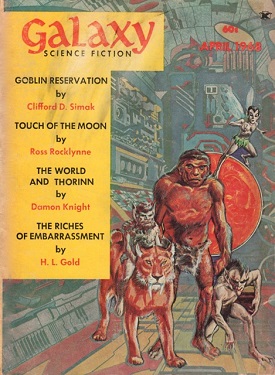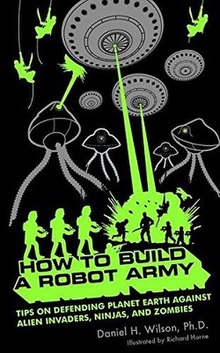
Alien invasion or space invasion is a common feature in science fiction stories and films, in which extraterrestrial lifeforms invade Earth to exterminate and supplant human life, enslave it, harvest people for food, steal the planet's resources, or destroy the planet altogether. It can be considered as a science-fiction subgenre of the invasion literature, expanded by H. G. Wells's seminal alien invasion novel The War of the Worlds, and is a type of 'first contact' science fiction.

Science fiction is a film genre that uses speculative, fictional science-based depictions of phenomena that are not fully accepted by mainstream science, such as extraterrestrial lifeforms, spacecraft, robots, cyborgs, mutants, interstellar travel, time travel, or other technologies. Science fiction films have often been used to focus on political or social issues, and to explore philosophical issues like the human condition.

Mechagodzilla is a fictional mecha character that first appeared in the 1974 film Godzilla vs. Mechagodzilla. In its debut appearance, Mechagodzilla is depicted as an extraterrestrial villain, a robot created by alien invaders to confront and destroy Godzilla. In subsequent iterations, Mechagodzilla is usually depicted as a man-made robotic weapon designed to defend Japan against Godzilla and other kaiju. In all incarnations, the character is portrayed as a robotic doppelgänger of Godzilla with a vast array of high-tech weaponry. Along with King Ghidorah, Mechagodzilla is commonly considered to be an archenemy of Godzilla.

Annalee Newitz is an American journalist, editor, and author of both fiction and nonfiction. From 1999 to 2008, Newitz wrote a syndicated weekly column called Techsploitation, and from 2000 to 2004 was the culture editor of the San Francisco Bay Guardian. In 2004, Newitz became a policy analyst at the Electronic Frontier Foundation. With Charlie Jane Anders, they also co-founded Other magazine, a periodical that ran from 2002 to 2007. From 2008 to 2015, Newitz was editor-in-chief of Gawker-owned media venture io9, and subsequently its direct descendant Gizmodo, Gawker's design and technology blog. They have written for the periodicals Popular Science, Film Quarterly and Wired. As of 2019, Newitz is a contributing opinion writer at The New York Times.

Many works of fiction have featured UFOs. In most cases, as the fictional story progresses, the Earth is being invaded by hostile alien forces from outer space, usually from Mars, as depicted in early science fiction, or the people are being destroyed by alien forces, as depicted in the film Independence Day. Some fictional UFO encounters may be based on real UFO reports, such as Night Skies. Night Skies is based on the 1997 Phoenix UFO Incident.

The Mysterians is a 1957 Japanese epic science fiction film directed by Ishirō Honda, with special effects by Eiji Tsuburaya. Produced and distributed by Toho Co., Ltd., it is the first Honda-Tsuburaya collaboration filmed in both color and TohoScope, and stars Kenji Sahara, Yumi Shirakawa, Momoko Kōchi, Akihiko Hirata, Yoshio Tsuchiya, Susumu Fujita, and Takashi Shimura, with Haruo Nakajima and Katsumi Tezuka as Mogera. In the film, Earth's defense forces unite to combat an extraterrestrial race that desires to intermarry with human women and settle on the planet.

Ninja Senshi Tobikage, known as Ninja Robots outside Japan and as Ninja Robot Tobikage by Studio Pierrot, is a Japanese anime television series, produced by Pierrot, which aired from 6 October 1985 to 13 July 1986 on Nippon Television. It was also broadcast to parts of Asia and Australia on Cartoon Network, but never aired in the United States.

Warning from Space is a Japanese tokusatsu science fiction film directed by Koji Shima. Produced and distributed by Daiei Film, it was the first Japanese science fiction film to be produced in color and predates Daiei's most iconic tokusatsu characters, Gamera and Daimajin. In the film's plot, starfish-like aliens disguised as humans travel to Earth to warn of the imminent collision of a rogue planet and Earth. As the planet rapidly accelerates toward Earth, a nuclear device is created at the last minute and destroys the approaching world.

Daniel H. Wilson is a New York Times bestselling author, television host and robotics engineer. He currently resides in Portland, Oregon. His books include the award-winning humor titles How to Survive a Robot Uprising, Where's My Jetpack? and How to Build a Robot Army and the bestseller Robopocalypse.

Doraemon: Nobita and the Steel Troops is a 1986 Japanese animated science fiction action-adventure film based on the seventh volume of the same name of the Doraemon Long Stories series. The original plot was written by Fujiko F. Fujio. Alternate titles include The Platoon of Iron Men, or The Robot Army. The film pays homage to many anime series featuring giant robots or "mecha", most notably Gundam and Mazinger. It is the seventh Doraemon film. In 2011, the film was remade as Doraemon: Nobita and the New Steel Troops—Winged Angels. The film is partly based on the 1980 chapter "Handmade Robot Rampage".

The Goblin Reservation is a 1968 science fiction novel by American writer Clifford D. Simak, featuring an educated Neanderthal, a biomechanical sabertooth tiger, aliens that move about on wheels, a man who time-travels using an unreliable device implanted in his brain, a ghost, trolls, banshees, goblins, a dragon and even Shakespeare himself. The Goblin Reservation was a Hugo Award nominee in 1969 and was originally serialized in Galaxy Science Fiction magazine.

Target Earth is a 1954 independently made American black-and-white science fiction film, produced by Herman Cohen, directed by Sherman A. Rose, that stars Richard Denning, Kathleen Crowley, Virginia Grey, and Whit Bissell. The film was distributed by Allied Artists Pictures Corporation.

The Day the Earth Stopped is a 2008 American direct-to-DVD science fiction action horror film produced by independent studio The Asylum, directed by and starring C. Thomas Howell. It is a mockbuster of the 2008 remake of The Day the Earth Stood Still, which was released three days later. Howell stars as the protagonist, soldier Josh Myron, who witnesses the arrival of giant alien robots that threaten to destroy the Earth unless they are shown the value of human existence.
Monsterpocalypse is a Kaiju-themed collectible miniatures game which is published by Privateer Press. Released series include Rise, I Chomp NY, All Your Base, Monsterpocalypse Now and the current series Big in Japan.

Carnival is a 2006 science fiction novel by Elizabeth Bear, published in the US by Bantam Spectra. It was nominated for a Philip K. Dick Award, a Locus Award for Best Science Fiction Novel and a Lambda Literary Award.
The year 2017 was marked, in science fiction, by the following events.

Autonomous is a 2017 science fiction novel by Annalee Newitz. It is Newitz's debut novel and was published by Tor Books on September 19, 2017. Set in a near future Earth, the book describes a world where both humans and intelligent robots can be owned as property. The events of the novel follow Jack, a "drug pirate" who manufactures illegal versions of patented drugs, and Paladin, a combat robot who is owned by the law enforcement agency searching for Jack after one of the drugs she reverse-engineered turns out to have dangerous side effects.














